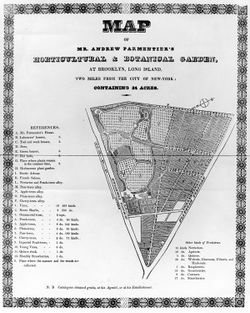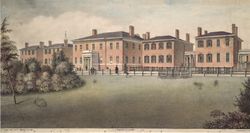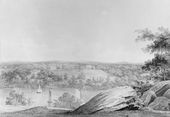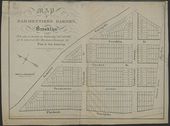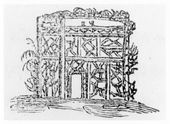André Parmentier
Overview
Birth Date: July 3, 1780
Death Date: November 27, 1830
Used Keywords: Alley, Arbor, Border, Botanic garden, Bridge, Cemetery/Burying ground/Burial ground, Drive, Fence, Ferme ornée/Ornamental farm, Hedge, Hermitage, Hothouse, Landscape gardening, Modern style/Natural style, Park, Pavilion, Picturesque, Plantation, Pot, Prospect, Rustic style, Seat, Shrubbery, Sundial, View/Vista, Walk, Wood/Woods
André Joseph Ghislain Parmentier (July 3, 1780–November 27, 1830) was a Belgian-born horticulturalist who immigrated to Brooklyn in 1824, where he established his Horticultural and Botanical Garden. He was known for importing European fruit trees, grape vines, and roses to the United States, and for introducing the country to the modern style of landscape gardening.
History
André Parmentier was born in 1780 in Enghien, Belgium, to a Walloon family that had been ennobled in the 16th century.[1] He counted among his relatives a number of celebrated botanists and horticulturalists: a cousin, Antoine Augustin Parmentier, who was known for introducing the potato to France, and two of his brothers—Joseph Julien Ghislain Parmentier (1775–1852) and Louis Joseph Ghislain Parmentier (1782–1847)—who were also recognized for their work in horticulture. Joseph served as mayor of Enghien from 1802 to 1830 and oversaw the rehabilitation of the Duke of Arenburg’s formal gardens, which had fallen into disrepair during the political upheavals in Europe; he also developed his own expansive garden that featured many rare and exotic plants.[2] Louis likewise established his own garden and was known as great rosiériste, trading in the more than 3000 varieties of roses he had cultivated at Enghien.[3]
Although the precise reasons are not fully clear as to André Parmentier’s decision to immigrate to America with his wife Sylvie, 8-year-old daughter Adèle, and 4-year-old son Léon, he is believed to have suffered serious financial difficulties in Belgium due to a failed speculation.[4] Like his brothers, he had established an international reputation in the field of horticulture, and less than a month after he and his family arrived in the United States on May 31, 1824, he was unanimously elected to membership in the New-York Horticultural Society.[5] By June 1825, he was already advertising his newly established nursery in Brooklyn, Parmentier’s Horticultural and Botanical Garden [Fig. 1].[6]
At his nursery Parmentier worked doggedly to corner the market on certain types of plants, such as grape vines, which he sold by subscription, offering a warranty to purchasers that the plants would be fruitful, “provided that his instructions are followed.”[7] Parmentier was clearly reliant on his brothers for portions of his stock, with grape vines and fruit trees—especially pears—being a specialization of his brother Joseph.[8] The advertisements for Parmentier’s Brooklyn nursery often mention fruit trees specifically, and he submitted a letter on the cultivation of pears in America to the Société d’Horticulture de Paris, which later published it in their Annales.[9] He also did a brisk business in roses, the primary focus of his brother Louis. An 1827 advertisement points out: “At the green houses in Mr. Parmentier’s Horticultural Garden in Brooklyn . . . the admirers of flowers may see many rare and elegant varieties of roses. . . . As these plants are cultivated in pots, their transportation may be safely effected at any season.”[10]
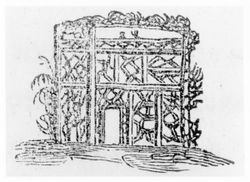
Parmentier was not, however, solely a nurseryman; he was also a landscape designer. His Horticultural and Botanical Garden differed from other nurseries in its layout, which was not purely utilitarian but featured serpentine walks, a rustic belvedere, and other key elements of the modern or naturalistic style of landscape gardening. As early as March 1826 Parmentier had begun to advertise “on the advice of several of his friends” his landscape services along with his nursery business, and he is known to have provided designs for Hawkswood, in Pelham, New York; the University of Toronto (originally King’s College) [Fig. 3]; and Moss Park, also in Toronto.[11] His essay “The Art of Landscape Gardening,” which articulates the primary features of the modern style of landscape design, was incorporated into Thomas Fessenden’s The New American Gardener (1828). A. J. Downing, in his Treatise on the Theory and Practice of Landscape Gardening, identified Parmentier as the first practitioner of this style in America, citing the layout and design of the Horticultural and Botanical Garden, as well as Parmentier’s contributions to the design of David Hosack's estate on the Hudson River, Hyde Park [Fig. 4].[12]
The degree of success André Parmentier achieved as a nurseryman and landscape designer in the United States belies the short six and a half years he lived in the country. On November 27, 1830, after “seven weeks and three days” of an undefined illness, he died at his home in Brooklyn. Following his death his daughter Adèle paid tribute to her father in a letter published in several newspapers, noting that his final wish was for his widow, Sylvie, “to continue the establishment for the good of his children.”[13] Sylvie Parmentier continued to maintain the nursery for the next three years, but ultimately sold it for $53,000 in October 1833. The plot was then divided into lots and auctioned off the following month.[14]
—Elizabeth Athens
Texts
- Anonymous, June 28, 1824, “Horticultural Memoranda” (New-York American)[15]
- “Ninety-seven new members had signed the constitution [of the New-York Horticultural Society] since the last sitting and were unanimously elected: amongst this number are . . . two distinguished horticulturists from Europe, Mr. Stead, from the Botanic Garden of Liverpool, member of the Yorkshire Horticultural Society, and Mr. Parmentier, of Enghien, a member of the scientific societies of that place, and of Brussels. These gentlemen have brought with them an extensive collection of fruit trees, rare plants, and seeds.”
- Anonymous, June 6, 1825, advertisement for Parmentier’s Horticultural and Botanical Garden (New-York Evening Post)[16]
- "ANDREW PARMENTIER has established himself in America with a view to Horticulture, and has already set on foot a nursery of considerable extent and variety, of ornamental & fruit-bearing trees, at the cross-roads formed by the intersection of the Jamaica & Flatbush turnpikes. . . . He has also a fine collection of shrubs and flowers, in pots, for sale.
- “Mr. P. intends to devote particular care to adding to his collection, those European fruits and remarkable rare trees, which are as yet unknown here, or have not been generally introduced into the United States.
- “Mr. Parmentier will be happy to exhibit his garden and nursery to the ladies and gentlemen of New York, who may honor him with a visit.”
- Anonymous, April 6, 1827, “Mr. Parmentier” (National Advocate (New York))[17]
- “There are few individuals in our country to whom the friends of agriculture and Botany are more indebted than to Mr. Parmentier of King’s county, Long Island. At an immense expense he has imported, from all parts of Europe, the choicest seeds, fruit and other trees, the collection of which he is introducing into the United States with great success. He is deserving of all encouragement, and we strongly recommend his establishment to public patronage.”
- Anonymous, July 7, 1827, “Establishment of Vineyards in the States of New York, New Jersey and Connecticut” (Salem (MA) Observer)[18]
- “Not less than seven vineyards have been established in these states from the plants furnished by Mr. Andrew Parmentier, at the Horticultural Garden, Brooklyn, L. I. and that they are all in the most flourishing condition. Two of these vineyards are at Middletown, (N. J.) and not a single plant has failed. Those at Yellow Hook, Flatbush, and Flatbush hill, (L. I.) are equally successful. The one at Bridgeport, (Conn.) is very flourishing, and that at Phillipstown, (N. Y.) is coming on well. Several other establishments of the same kind are about to be undertaken under the superintendence of Mr. P. who warrants his grape-vines to live, provided that his instructions are followed, and that the order sent is for more than one hundred plants.”
- Parmentier, André, 1828, “The Art of Landscape Gardening” (Fessenden 1828: 185–87)[19]
- “. . . For where can we find an individual, sensible to the beauties and charms of nature, who would prefer a symmetric garden to one in modern taste; who would not prefer to walk in a plantation irregular and picturesque, rather than in those straight and monotonous alleys, bordered with mournful box, the resort of noxious insects?
- “Where is the person, gifted with any taste, who would not choose those alleys that wind without constraint, in preference to those dull straight lines which can be measured by one glance of the eye, and the monotony of which is unvaried? Instead of this, the modern style presents to you a constant change of scene, perfectly in accordance with the desires of a man who loves, as he continues his walk, to have new objects laid open to his view. . . . Limited prospects, and neighbouring houses and buildings not worthy of notice, should be concealed, and the view left open to those objects which strike the eye of the beholder agreeably. . . .
- “The plantations and groups of trees near the house should be, if possible, of a deeper green;— they would extend the view and the perspective, and produce the effect of shades in a landscape-picture, where the groups of trees in front are of a darker shade, and seem to remove the perspective from the extremity of the landscape. . . .
- “The most should be made of the agreeable and interesting views which may be had in the neighbouring landscape. They may be made useful to the general plan by being represented as the property of the proprietor.
- “For this reason, I highly approve of blind fences, and live hedges. But fences, necessary as enclosures, should be concealed so as not to appear as boundaries to the establishment, and present to the eye a disagreeable interruption in the prospect. The judicious use of hermitages, arbours, cottages, and rotundas will add to the effect, in picturesque gardens and ornamented farms. If you use these ornaments, place the hermitage in some retired spot: a small rivulet would be an appropriate and beautiful accompaniment . . .
- “As to tombs and cemeteries, I should wish to banish them entirely from gardens. They always awaken melancholy reflections in old people, for they remind them of their approaching end; and a regard for their feelings should, I think, exclude from their places of resort every object which could have such an effect.”
- Anonymous, January 4, 1828, “Rural Scenery” (New England Farmer 6: 187)[20]
- “Landscape and Picturesque Gardens.—Among the embellishments which attend the increase of wealth, the cultivation of the sciences, and the refinement of taste, none diversify and heighten the beauty of rural scenery, more than picturesque and landscape gardens. . . .
- “For the introduction into this country of the design and execution of landscape and picturesque gardening, the public is much indebted to Mr. A. Parmentier, proprietor of the Horticultural Botanic Garden, Brooklyn, two miles from this city. His own garden, for which he made so advantageous a choice, may give us some idea of his taste. The borders are composed of every variety of trees and shrubs that are found in his nurseries. The walks are sinuous, adapted to the irregularity of the ground, and affording to visitors a continual change of scenery, which is not enjoyed in gardens laid out in even surfaces, and in right lines. His dwelling and French saloon are in accordance with the surrounding rural aspect. In his gardens are 25,000 vines planted and arranged in the manner of the vineyards of France.”
- Parmentier, Adèle, November 29, 1830, describing her father, André Parmentier (quoted in New-York Spectator)[21]
- “Mr. Smith.—My mother desires me to fulfil the painful duty of informing you of the terrible loss we have sustained in the death of my dear father, after an illness of seven weeks and three days. His personal qualities and mild character made him the best of husbands and fathers. The establishment under his good management and honest principles, had acquired a reputation which he so well merited, and which was about to enable him to reap the fruits of his labors and industry, when death cruelly took him away from his afflicted family. His last moments were those of a good christian. He was not only resigned to die, but wished for death. He bore with the greatest patience and courage his great sufferings, and spoke to us about all our duties, and expressed the hope that we would die like him a tranquil and calm conscience. He was sensible to his last moment, and wished my dear mother to continue the establishment for the good of his children, which she hopes to do. . . .”
- Downing, Alexander Jackson, 1841, describing Hyde Park, the residence of David Hosack (1841: 22)[22]
- “Hyde Park, on the Hudson, the seat of the late Dr. Hosack, has been justly celebrated as one of the finest specimens of the modern style of Landscape Gardening in America. Nature has indeed, done much for this place, as the grounds are finely varied, beautifully watered by a lively stream, and the views from the neighbourhood of the house itself, including as they do the noble Hudson, and the superb wooded valley which stretches away until bounded at the horizon by the distant summits of the blue Cattskills, are unrivalled in picturesque beauty. But the efforts of art are not unworthy so rare a locality; and while the native woods, and beautifully undulating grounds are preserved in their original state, the pleasure-grounds, roads, walks, drives, and new plantations, have been laid out in so tasteful a manner as to heighten the charms of nature. Large and costly hot-houses were erected and elegant entrance lodges at two points on the estate, a fine bridge over the stream, and numerous pavilions and seats commanding extensive prospects; in short, nothing was spared to render this seat one of the finest in America. The park, which at one time contained some fine deer, afforded a delightful drive within itself, as the whole estate numbered about seven hundred acres. The plans for laying out the grounds were furnished by Parmentier, and architects from New York were employed in designing and erecting the buildings. Since the death of Dr. Hosack, the place has lost something of the high keeping which it formerly evinced, but we still consider it one of the most instructive seats in this country.”
Images
Anonymous, Map of Mr. Andrew Parmentier’s Horticultural and Botanical Garden, at Brooklyn, Long Island, Two Miles From the City of New York, c. 1828.
Nathaniel Currier, Hyde Park, Hudson River, c. 1835.
Notes
- ↑ “Biographie Enghiennoise,” Mémoires et publications de la Société des sciences, des arts et des lettres (Mons: Dusquesne Masquillier, 1876), 485, view on Zotero.
- ↑ Patrick Neal, Journal of a Horticultural Tour through Some Parts of Flanders, Holland, and the North of France, in the Autumn of 1817 (Edinburgh: Bell and Bradfute, 1823), 325–32, view on Zotero.
- ↑ Fr. Mertens, “Les roses de Louis Parmentier (1782–1847),” Annales du cercle archeologique d’Enghien 26 (1990): 86, view on Zotero.
- ↑ An 1821 court case, in which André Parmentier struggled to recoup outstanding debt, may have contributed to his financial difficulties; see Pasicrisie belge: Recueil général de la jurisprudence des cours de Belgique en matière civile, commerciale, criminelle, de droit public et administratif (Brussels: Adolphe Wahlen et Cie, 1844), 125.
- ↑ “Horticultural Memoranda,” American [New York] (June 28, 1824): 2, view on Zotero.
- ↑ Advertisement, New-York Evening Post (June 6, 1825): 3, view on Zotero.
- ↑ “Establishment of Vineyards in the States of New York, New Jersey and Connecticut,” Salem (MA) Observer (July 7, 1827): 3, view on Zotero. On July 26, 1827, Parmentier’s nursery was the subject of a vitriolic letter to the editor of the American, in which the author—identified only by the pseudonym “A Friend to the Vine”—claimed that “[i]t cannot but be inferred . . . that Mr. P. would wish to be the only importer of the grape vine for cultivation into this country.”
- ↑ Cynthia Zaitzevsky, “Parmentier, André (1780–1830),” in Charles A. Birnbaum and Robin Karson, eds., Pioneers of American Landscape Design (New York: McGraw-Hill, 2000), 286, view on Zotero. In 1824 Joseph sent a list of nearly 200 pear varieties, along with descriptions of the fruits’ texture, size, and flavor, to the Horticultural Society of London. See Joseph Parmentier, “A List of Pears Cultivated in France and the Netherlands . . . ,” Transactions of the Horticultural Society of London 5 (1824): Appendix II, view on Zotero.
- ↑ André Parmentier, “Sur les Arbres fruitiers d’Amérique,” Annales de la Société d’Horticulture de Paris 4 (1829): 351–53, view on Zotero.
- ↑ “Mr. Parmentier’s Garden,” New-York Evening Post (May 19, 1827): 2, view on Zotero.
- ↑ “On Landscape and Picturesque Gardens,” New-York Evening Post (March 4, 1826): 3, view on Zotero; see also Zaitzevsky 2000, 286, view on Zotero.
- ↑ A. J. Downing, A Treatise on the Theory and Practice of Landscape Gardening (New York: Wiley and Putnam; Boston: C. C. Little & Co., 1841), 22, view on Zotero.
- ↑ The letter, dated November 29, 1830, was sent to the editor of the New England Farmer and republished in several newspapers; this excerpt is quoted from the New-York Spectator (December 28, 1830): 1, view on Zotero.
- ↑ Some papers cite the original sale price as $57,000; see “Price of Farms,” New-York American (November 22, 1833): 4, view on Zotero. For additional details of the sale and subsequent auction, see “Parmentier’s Garden,” New-York Evening Post (October 23, 1833): 2, view on Zotero, “All in the Wrong,” Commercial Advertiser [New York] (November 9, 1833): 3, view on Zotero, and New-York American (November 19, 1833): 4, view on Zotero.
- ↑ “Horticultural Memoranda,” New-York American (June 28, 1824): 2, view on Zotero.
- ↑ Advertisement, New-York Evening Post (June 6, 1825): 3, view on Zotero.
- ↑ “'Mr. Parmentier,” National Advocate (New York), (April 6, 1827): 2, view on Zotero.
- ↑ “Establishment of Vineyards in the States of New York, New Jersey and Connecticut,” Salem (MA) Observer (July 7, 1827): 3, view on Zotero.
- ↑ André Parmentier, “The Art of Landscape Gardening,” in Thomas Fessenden, The New American Gardener (Boston: J. B. Russell, 1828), 184–87, view on Zotero.
- ↑ “Rural Scenery,” New England Farmer 6, no. 24 (January 4, 1828): 187, view on Zotero.
- ↑ “The Late Mr. Parmentier,” New-York Spectator (December 28, 1830): 1, view on Zotero
- ↑ A. J. Downing, A Treatise on the Theory and Practice of Landscape Gardening (New York: Wiley and Putnam; Boston: C. C. Little & Co., 1841), view on Zotero.
